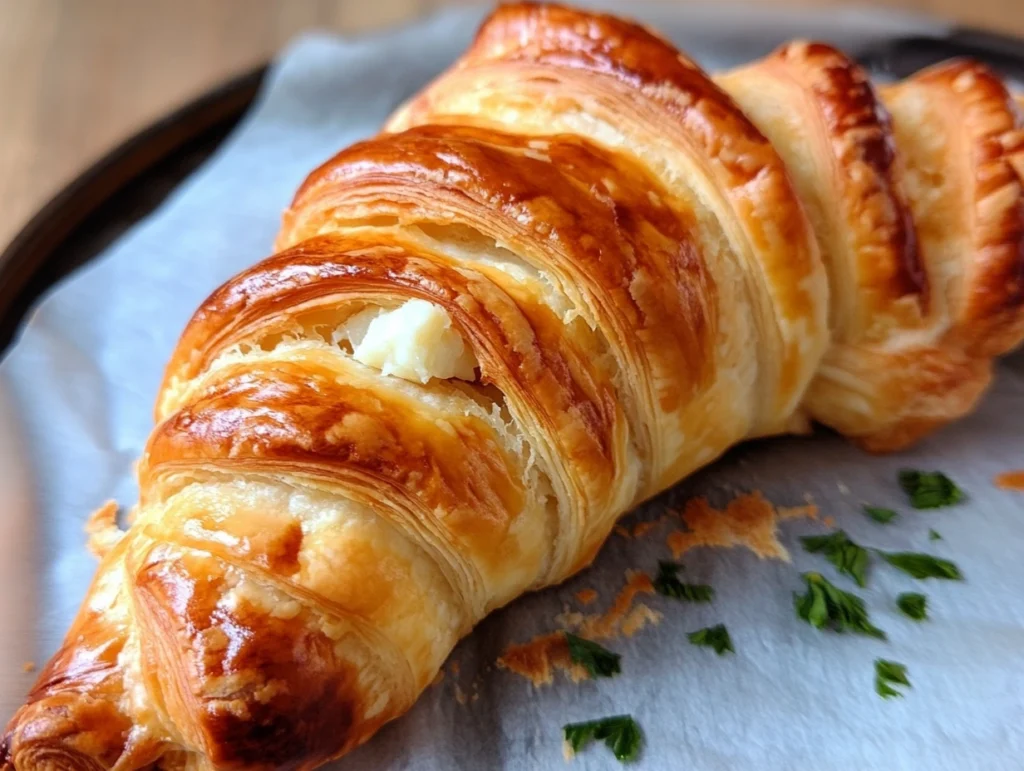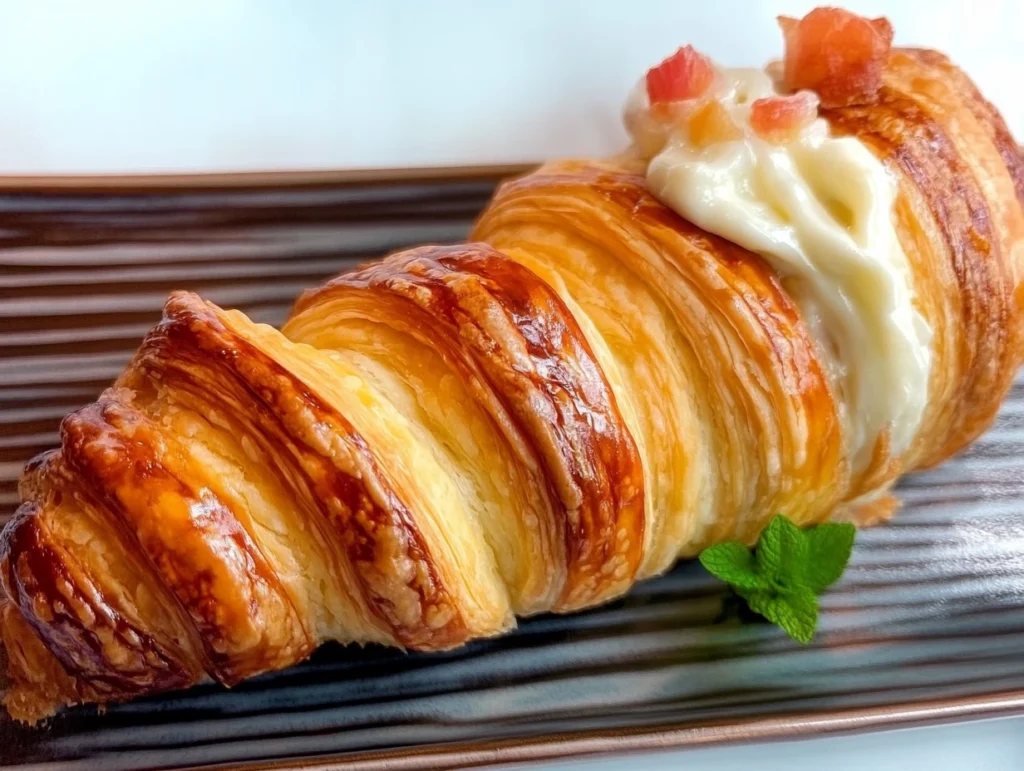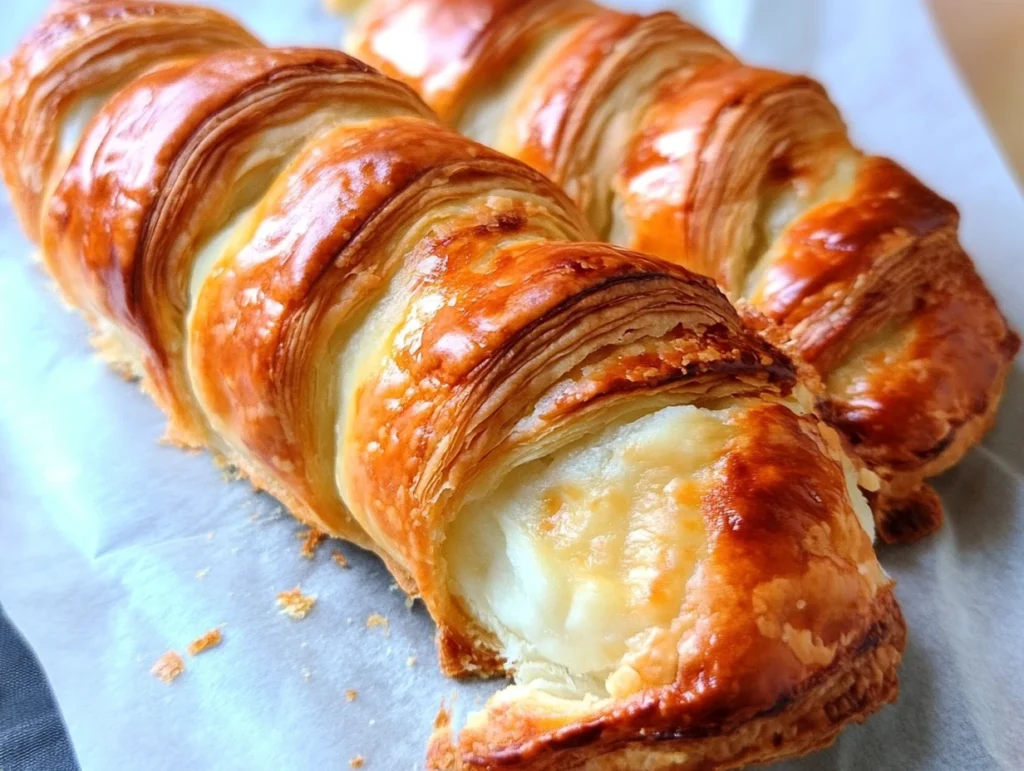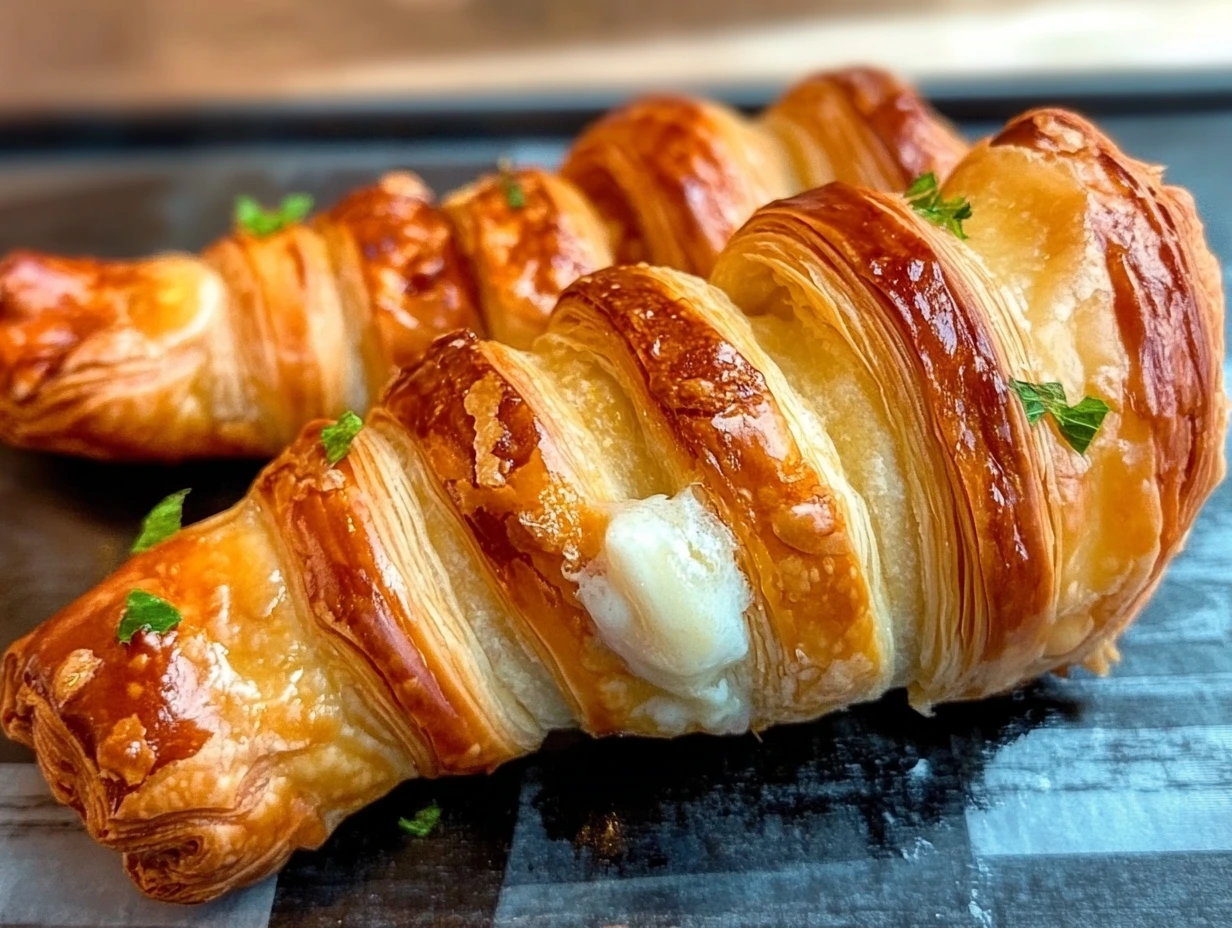The Lobster Tail pastry, also known as “code di aragosta” in Italian, is a decadent and visually striking dessert. This pastry gets its name from its resemblance to a lobster’s tail, with layers of crisp, flaky dough fanning out into a curved, shell-like shape. Inside, it’s filled with a sweet and creamy filling, making it a beloved indulgence in Italian-American bakeries.
Table of Contents
Origins and History
The Lobster Tail pastry is a close relative of the traditional Italian sfogliatelle, a pastry that originated in the Campania region of Italy in the 17th century. While sfogliatelle has a denser filling, the Lobster Tail was developed in Italian-American communities as a variation that embraced lighter, creamier fillings like whipped cream or custard. The Lobster Tail reflects the evolution of traditional Italian baking to suit broader tastes, especially in the United States.
Key Characteristics
The Lobster Tail pastry is characterized by:
- Shape: The pastry is named for its layered, crescent-like shape that resembles a lobster tail.
- Dough: Made from a laminated dough similar to puff pastry, with thin, flaky layers.
- Filling: Typically filled with sweet ricotta, custard, whipped cream, or a combination, creating a luscious contrast to the crisp pastry.
- Texture: The exterior is golden and crispy, while the interior is soft and creamy.
- Topping: It’s often dusted with powdered sugar for a delicate finish.
How Lobster Tail Pastry Differs from Sfogliatelle
Though the Lobster Tail and sfogliatelle share visual similarities, they have distinct differences in ingredients, texture, and taste.
Ingredients Used
- Lobster Tail: Uses a dough similar to puff pastry or choux pastry for a lighter and flakier texture. The filling often incorporates whipped cream or custard.
- Sfogliatelle: Traditionally made with semolina-based dough, the filling includes ricotta cheese, candied citrus peels, and sometimes semolina flour, giving it a denser and more traditional Italian flavor.
Texture and Taste
- Lobster Tail: Crisp, airy layers give way to a rich, creamy filling, making it a sweeter and more indulgent dessert.
- Sfogliatelle: Dense and slightly chewy, with a filling that leans more toward sweetened ricotta with citrusy undertones, offering a less creamy but more traditional experience.

Ingredients Needed for Lobster Tail Pastry
Dough Ingredients
To create the iconic flaky layers of the Lobster Tail pastry, you’ll need the following:
- All-purpose flour – 2 ½ cups
- Salt – 1 tsp
- Sugar – 1 tbsp
- Unsalted butter – ½ cup, cold and cubed
- Water – ½ cup, cold
- Eggs – 2 large (for egg wash)
- Shortening or lard – ⅓ cup (to help achieve the delicate, flaky texture)
Cream Filling Ingredients
The creamy filling inside the Lobster Tail pastry is versatile. Here’s a basic combination:
- Heavy cream – 1 cup (for whipped cream)
- Ricotta cheese – 1 cup, smooth and creamy
- Confectioners’ sugar – ½ cup, sifted
- Vanilla extract – 1 tsp
- Optional flavoring – Lemon zest, almond extract, or cinnamon, depending on your preference
Step-by-Step Recipe for Lobster Tail Pastry
Making the Dough
- Prepare the Dough Base:
- In a large mixing bowl, combine the flour, salt, and sugar. Add the cold, cubed butter and shortening. Using your hands or a pastry cutter, work the fats into the flour until the mixture resembles coarse crumbs.
- Add Water Gradually:
- Slowly incorporate the cold water, mixing until the dough just comes together. Be careful not to overwork the dough to ensure it stays tender.
- Chill the Dough:
- Wrap the dough in plastic wrap and refrigerate for at least 2 hours or overnight. Chilling allows the gluten to relax and the butter to firm up, which is key to flaky layers.
- Roll and Laminate:
- Roll out the dough into a thin rectangle, brush it with melted shortening or lard, and fold it like a business letter. Repeat this rolling and folding process 3–4 times, refrigerating the dough between folds to keep it cold.
Preparing the Filling
- Whip the Cream:
- In a cold mixing bowl, beat the heavy cream with a hand or stand mixer until soft peaks form.
- Combine Ingredients:
- In a separate bowl, mix the ricotta cheese, confectioners’ sugar, vanilla extract, and any optional flavorings until smooth. Gently fold the whipped cream into the ricotta mixture to create a light, airy filling.
- Chill the Filling:
- Cover the filling and refrigerate until ready to use.
Shaping and Baking
- Shape the Pastries:
- Roll out the chilled dough into a thin rectangle. Cut the dough into strips, about 3 inches wide. Starting from one end, roll the strip into a cone shape, leaving the outer layers slightly loose to create the “lobster tail” appearance.
- Fill the Pastry:
- Spoon or pipe the cream filling into the cavity of each pastry cone, being careful not to overfill.
- Brush with Egg Wash:
- Beat the eggs to create an egg wash and brush it lightly over the pastry’s exterior for a golden, shiny finish.
- Bake:
- Preheat the oven to 375°F (190°C). Place the pastries on a lined baking sheet and bake for 20–25 minutes, or until golden brown and crisp.
- Cool and Serve:
- Allow the pastries to cool slightly before dusting them with confectioners’ sugar. Serve fresh for the best taste and texture.
Common Mistakes When Making Lobster Tail Pastry
Dough Consistency Issues
- Dough Too Dry:
- If the dough is too dry, it can crack during rolling, preventing the creation of smooth layers. Always add water gradually and stop when the dough just comes together.
- Overworking the Dough:
- Overmixing or kneading the dough too much can develop too much gluten, making it tough and difficult to roll. Work quickly and handle the dough minimally.
- Improper Chilling:
- Skipping or shortening the chilling time can cause the butter in the dough to melt prematurely, leading to greasy or dense pastries instead of flaky layers.
Overcooking or Undercooking
- Overcooking:
- Baking the pastries for too long can result in overly dry and brittle layers, losing the signature delicate crispness. Keep a close eye on them toward the end of the baking time.
- Undercooking:
- If the pastry is underbaked, the inner layers will be doughy and heavy. Bake until the exterior is golden brown, and the layers appear fully puffed.
- Inconsistent Oven Temperature:
- Not preheating the oven or baking at an incorrect temperature can cause uneven cooking. Use an oven thermometer to ensure accuracy.

Tips and Tricks for Perfect Lobster Tail Pastry
Best Tools to Use
- Pastry Roller or Rolling Pin:
- A sturdy rolling pin is essential for evenly flattening the dough and achieving thin, uniform layers.
- Pastry Brush:
- Use a pastry brush to apply melted shortening or lard evenly during the lamination process and to apply egg wash for a golden finish.
- Piping Bag:
- A piping bag with a wide nozzle is the best way to neatly and efficiently fill the pastry shells with cream.
- Bench Scraper:
- A bench scraper can help cut and shape the dough precisely and cleanly.
Expert Techniques for Shaping
- Work Quickly:
- When shaping the dough, work quickly to prevent the butter from melting. If the dough becomes too warm, return it to the fridge to chill.
- Shape with Loose Layers:
- When rolling the dough strips into cones, leave the outer layers slightly loose. This creates the signature “lobster tail” look and ensures the layers puff up during baking.
- Avoid Overfilling:
- Be mindful not to overfill the pastries with cream, as it can cause the dough to tear or leak during baking.
- Use a Light Hand:
- Handle the dough gently to avoid compressing the layers. Light pressure helps preserve the airy texture of the pastry.
- Bake One Batch at a Time:
- To ensure even baking, avoid overcrowding the oven. Bake in smaller batches if necessary.
Popular Variations of Lobster Tail Pastry
Chocolate-Filled Lobster Tail Pastry
For chocolate lovers, the Lobster Tail pastry can be transformed into a decadent treat by adding chocolate:
- Chocolate Cream Filling:
- Replace or mix the traditional cream filling with a rich chocolate ganache or chocolate-flavored custard.
- Add cocoa powder to the whipped cream for a light, mousse-like chocolate filling.
- Chocolate Drizzle:
- Finish the pastry by drizzling melted dark, milk, or white chocolate over the top for added flavor and a decorative touch.
- Add Chocolate Chips:
- Mix mini chocolate chips into the cream filling for bursts of chocolate in every bite.
Savory Lobster Tail Variations
Although traditionally sweet, Lobster Tail pastries can also be reimagined as savory delights:
- Cheese and Herb Filling:
- Swap the sweet filling for a savory mixture of ricotta cheese, cream cheese, or goat cheese blended with fresh herbs like basil, thyme, or parsley.
- Meat and Veggie Fillings:
- Use fillings like seasoned ground beef, sautéed mushrooms, or spinach and feta for a hearty, savory twist.
- Savory Toppings:
- Instead of powdered sugar, sprinkle the tops with grated Parmesan, sesame seeds, or a hint of paprika before baking.
Nutritional Information
Caloric Content
- A standard Lobster Tail pastry (approximately 150–200g) typically contains 400–600 calories.
- The caloric content varies depending on the size of the pastry, the type and quantity of filling, and any additional toppings or ingredients used (e.g., chocolate or savory elements).
Protein, Fat, and Carbs Breakdown
- Protein:
- The pastry provides around 6–8g of protein, primarily from the ricotta filling and any eggs used in the dough or filling.
- Fat:
- Lobster Tail pastries are rich in fat due to the butter and shortening in the dough and the cream-based filling, containing around 20–30g of fat per serving.
- Carbohydrates:
- The pastry is high in carbs due to the dough and sugar content, averaging 40–60g of carbs per serving.
- Note for Variations:
- Chocolate-filled versions tend to have higher sugar and fat content, while savory variations may contain less sugar and more protein depending on the filling.
Pairing Lobster Tail Pastry with Drinks
Coffee Pairings
- Espresso:
- The rich and creamy filling of the Lobster Tail pastry pairs beautifully with the bold, concentrated flavors of espresso. The bitterness of the coffee balances the sweetness of the pastry.
- Cappuccino or Latte:
- For those who enjoy a creamier coffee, cappuccinos or lattes complement the pastry’s flaky layers and luscious filling without overpowering its delicate flavors.
- Macchiato:
- A touch of milk in a macchiato mirrors the creaminess of the pastry, creating a harmonious flavor experience.
- Flavored Coffees:
- Vanilla, hazelnut, or caramel-flavored coffees add an extra layer of sweetness that pairs well with the pastry’s filling, especially if it has a hint of citrus or chocolate.
Dessert Wines
- Moscato d’Asti:
- This light, slightly sparkling Italian wine has a sweet, fruity profile that complements the Lobster Tail pastry without overwhelming its flavors.
- Vin Santo:
- A classic pairing for Italian desserts, Vin Santo’s nutty and honeyed notes enhance the richness of the pastry while balancing its sweetness.
- Prosecco:
- For a celebratory pairing, the crisp bubbles and light sweetness of Prosecco make an excellent companion to the pastry’s buttery layers.
- Port or Sherry:
- Rich and full-bodied dessert wines like port or cream sherry contrast beautifully with the flaky texture and creamy filling, especially for chocolate-filled variations.

Where to Buy Lobster Tail Pastry
Online Shops
- Specialty Italian Bakeries:
- Many Italian bakeries offer shipping services for Lobster Tail pastries. Look for reputable shops with good reviews, such as Ferrara Bakery (New York City) or Carlo’s Bakery (New Jersey).
- Gourmet Food Marketplaces:
- Websites like Goldbelly allow you to order Lobster Tail pastries from renowned bakeries across the country, delivering authentic flavors straight to your door.
- DIY Pastry Kits:
- Some bakeries and online stores sell kits with pre-made dough and filling, so you can assemble and bake Lobster Tail pastries at home.
Local Bakeries
- Italian Bakeries:
- Visit your local Italian bakery or pastry shop, as they are most likely to carry authentic Lobster Tail pastries. Ask if they offer variations or fillings to suit your taste.
- Farmers’ Markets:
- Some artisanal bakers sell Lobster Tail pastries at farmers’ markets or specialty food fairs. These often feature fresh, locally-sourced ingredients.
- Custom Orders:
- Many bakeries will accept custom orders if you’d like a specific flavor or a larger batch for special occasions.
FAQs About Lobster Tail Pastry
What’s the difference between lobster tail pastry and sfogliatelle?
While both pastries share a similar crescent shape and flaky, layered dough, their key differences include:
- Filling: Lobster tail pastries are typically filled with a creamy mixture of whipped cream, custard, or ricotta, while sfogliatelle traditionally contains a dense filling made from ricotta, semolina, and candied citrus peel.
- Texture: Lobster tail pastries have a lighter, airier texture due to their creamy filling, whereas sfogliatelle has a firmer, chewier interior.
- Origin: Sfogliatelle is a traditional Italian pastry, while the lobster tail pastry is a modern Italian-American adaptation.
Can you freeze lobster tail pastry?
Yes, you can freeze Lobster Tail pastries:
- Unbaked Pastries: Shape the dough, freeze them on a baking sheet until solid, then transfer to an airtight container. Bake directly from frozen, adding a few extra minutes to the cooking time.
- Baked Pastries: Allow the pastries to cool completely, then wrap them tightly in plastic wrap and store in a freezer-safe bag. Reheat in an oven at 350°F (175°C) until crisp and warmed through.
How long does it stay fresh?
- Freshly Baked: Lobster Tail pastries are best enjoyed the same day they are baked, as the dough is crisp and the filling is fresh.
- Storage: They can stay fresh for up to 2–3 days if stored properly in the refrigerator. However, the pastry may lose some of its crispness.
Is it difficult for beginners to make?
Making Lobster Tail pastries can be challenging for beginners due to the multi-step process and the need for precision. However:
- Dough Lamination: Creating the thin, layered dough requires time and practice.
- Filling and Shaping: Shaping the pastry into its signature lobster tail form can be tricky, but with patience, it’s achievable.
Can I make this without special tools?
Yes, you can make Lobster Tail pastries without specialized equipment:
- Rolling Pin: Essential for rolling out the dough. A wine bottle can work in a pinch.
- Pastry Brush: Helpful but not mandatory—you can use a spoon to spread melted shortening or egg wash.
- Piping Bag: If you don’t have one, use a resealable plastic bag with the tip cut off to fill the pastries.
What’s the best way to store it?
- Short-Term Storage: Place the pastries in an airtight container and refrigerate if not eaten immediately. Keep the filling cold to maintain freshness.
- Long-Term Storage: For longer storage, freeze unfilled pastries. Thaw and add the cream filling just before serving for the best texture and flavor.
- Reheating: To revive the crispness, reheat in the oven rather than a microwave.
To expand your readers’ exploration of Italian-inspired or decadent desserts, you can guide them to the Best Strawberry Cheesecake Recipe, which offers a fruity, creamy option perfect for any dessert table. For those interested in lighter baked goods, the Homemade Blueberry Bagels can be a satisfying alternative to pastries. Additionally, if readers enjoy working with laminated dough, they might also appreciate trying their hand at Chocolate Croissants or learning about What is Croissant Bread? to expand their baking repertoire.
Conclusion
Lobster Tail pastry is a delightful blend of Italian tradition and modern creativity, making it a standout dessert for any occasion. Its flaky, golden layers and creamy filling offer a unique indulgence that’s as satisfying to eat as it is to make. Whether you’re a seasoned baker or a curious beginner, understanding the origins, techniques, and variations of this pastry allows you to truly appreciate its charm.
Pairing it with the right coffee or dessert wine elevates the experience, while knowing how to store and serve it ensures it stays fresh and delicious. With endless possibilities for sweet and savory adaptations, the Lobster Tail pastry is a versatile treat that’s sure to impress.
Now that you have the ultimate guide, why not roll up your sleeves and give this iconic pastry a try? Whether made at home or sourced from a local bakery, it’s a taste of culinary artistry you won’t want to miss!

